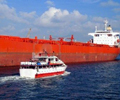|
|
 -->
Hiring canal boats in London costs more than supertankers earn from shipping Saudi Arabian crude to Japan as a glut of the oil transporters cuts freight
-->
Hiring canal boats in London costs more than supertankers earn from shipping Saudi Arabian crude to Japan as a glut of the oil transporters cuts freight
rates on the industry’s most important trade route.
Returns from the 1,000-foot long tankers plunged 99 percent to $585 a day over the past year for single-trip charters to deliver 2 million barrel cargoes, according to the London-based Baltic Exchange. Hiring a 57-foot pleasure craft on the Grand Union Canal that links London to Birmingham costs 395 pounds ($646) a day, the holidayuk.co.uk weBSIte shows.
The surplus of supertankers vying for Middle East cargoes has more than doubled to 23 percent this year as ships hit the water that were ordered in 2007 and 2008 when returns were higher, according to Bloomberg News surveys of shipowners and brokers. Ship fuel prices, representing owners’ single-largest expense, have climbed 28 percent in 2011, tracking crude oil.
“We try to avoid Arabian Gulf to East cargoes at these dismal numbers,” said Jens Martin Jensen, Singapore-based chief executive officer of the management unit of Frontline Ltd., which has enough tankers to supply the U.K. for more than two months. “We could see a return to profitability hopefully in the second half of the year” as demand strengthens.
A rebound of that magnitude would require average rental income to exceed $30,100 a day, Frontline’s last reported breakeven level once finance costs are taken into account. In the present market, owners would be “lucky” to secure charters above that level, he said.
Expanding Fleet
Owners are contending with a fleet that is expanding faster than seaborne trade in oil. The transportation capacity of the global fleet of very large crude carriers, or VLCCs as the supertankers are known, will swell 7.4 percent this year to 172.8 million deadweight tons, according to Clarkson Plc, the world’s largest shipbroker. Demand will grow 3.2 percent to 128.4 million tons, it said.
The ships were ordered in 2007 and 2008 when returns rose as high as $177,000 a day on the Saudi Arabia to Japan route, according to Baltic Exchange information that goes back to July 2008.
The carrying capacity of Frontline’s fleet, including smaller vessels than VLCCs, totals about 15.3 million deadweight tons. That would be enough to transport more than 110 million barrels of cargo. The U.K. consumed 1.6 million barrels a day in 2009, according to data from BP Plc.
Tanker Index
Frontline dropped 23 percent in Oslo this year to 115.4 kroner a share by 1:24 p.m. in London, giving the company a market value of 8.9 billion kroner ($1.6 billion). The six member Bloomberg Tanker Index, which spans owners of smaller ships, has lost 8.9 percent to 339.69 points.
The Saudi Arabia to Japan trade route is used to settle bets, or hedges, called forward freight agreements, or FFAs, linked to the cost of transporting crude oil.
Frontline will typically target westbound shipments, and then seek cargoes from either the Caribbean or West Africa back to Asia, limiting the time its ships are empty, the company’s annual report shows.
Just to pay crew, insurance and repairs, owners need $12,777 a day, according to Drewry Shipping Consultants Ltd. in London. Owners are even contributing $10,500 a day toward fuel costs to send ships to the U.S., according to Baltic Exchange data. The strategy allows companies to reposition ships in more profitable markets so they don’t have to pay the entire fuel charge.
Undercutting Shipowners
Oil companies that own ships or have them on long-term charters are temporarily undercutting conventional shipowners because they require fewer of the vessels during yearly refinery maintenance, said Erik Nikolai Stavseth, an analyst at Arctic Securities ASA in Oslo. That is adding to vessel supply and cutting charter rates, he said.
“You have a lot of oil companies re-letting vessels into the market and they don’t have any cash break-even level,” said Stavseth, who correctly predicted a surge in gasoline shipping stocks this quarter. “They say ‘we don’t need it, we make $10 a day, it’s better than making zero.’ That’s the oversupply we are seeing right now in the VLCC market.”
The collapse in spot rates has contributed to a slump in longer-term charter rates and the price that owners will pay to buy second-hand vessels. The purchase price of a second-hand VLCC has dropped 2.3 percent this year to $81.9 million, according to the Baltic Exchange. A yearlong rental of a similar ship has declined to $28,000 a day from $31,000 at the end of last year.
By contrast, hiring a canal boat remains an attractive proposition for tourists from around the world, said Barry Peters, managing director of Holidays in the U.K.
“Traveling slowly along the network of canals in a narrow boat and stopping at pubs and attractions is an unmatched experience,” said Peters. “I am astonished that supertankers can be hired for so little.”
Source: Alaric Nightingale, Bloomberg |
|